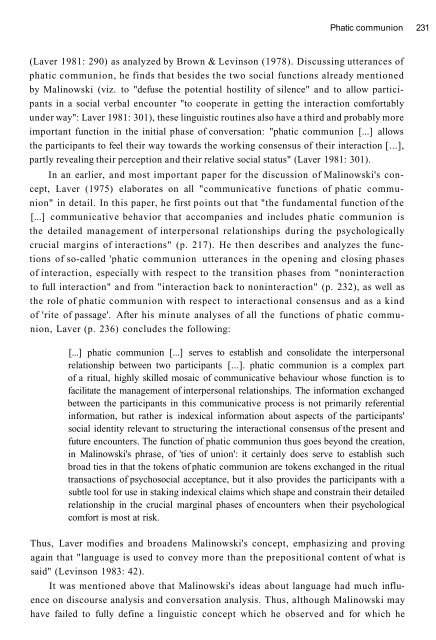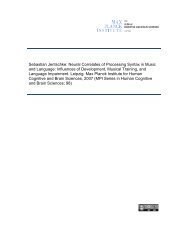Phatic communion - PubMan
Phatic communion - PubMan
Phatic communion - PubMan
You also want an ePaper? Increase the reach of your titles
YUMPU automatically turns print PDFs into web optimized ePapers that Google loves.
<strong>Phatic</strong> <strong>communion</strong> 231<br />
(Laver 1981: 290) as analyzed by Brown & Levinson (1978). Discussing utterances of<br />
phatic <strong>communion</strong>, he finds that besides the two social functions already mentioned<br />
by Malinowski (viz. to "defuse the potential hostility of silence" and to allow participants<br />
in a social verbal encounter "to cooperate in getting the interaction comfortably<br />
under way": Laver 1981: 301), these linguistic routines also have a third and probably more<br />
important function in the initial phase of conversation: "phatic <strong>communion</strong> [...] allows<br />
the participants to feel their way towards the working consensus of their interaction [...],<br />
partly revealing their perception and their relative social status" (Laver 1981: 301).<br />
In an earlier, and most important paper for the discussion of Malinowski's concept,<br />
Laver (1975) elaborates on all "communicative functions of phatic <strong>communion</strong>"<br />
in detail. In this paper, he first points out that "the fundamental function of the<br />
[...] communicative behavior that accompanies and includes phatic <strong>communion</strong> is<br />
the detailed management of interpersonal relationships during the psychologically<br />
crucial margins of interactions" (p. 217). He then describes and analyzes the functions<br />
of so-called 'phatic <strong>communion</strong> utterances in the opening and closing phases<br />
of interaction, especially with respect to the transition phases from "noninteraction<br />
to full interaction" and from "interaction back to noninteraction" (p. 232), as well as<br />
the role of phatic <strong>communion</strong> with respect to interactional consensus and as a kind<br />
of 'rite of passage'. After his minute analyses of all the functions of phatic <strong>communion</strong>,<br />
Laver (p. 236) concludes the following:<br />
[...] phatic <strong>communion</strong> [...] serves to establish and consolidate the interpersonal<br />
relationship between two participants [...]. phatic <strong>communion</strong> is a complex part<br />
of a ritual, highly skilled mosaic of communicative behaviour whose function is to<br />
facilitate the management of interpersonal relationships. The information exchanged<br />
between the participants in this communicative process is not primarily referential<br />
information, but rather is indexical information about aspects of the participants'<br />
social identity relevant to structuring the interactional consensus of the present and<br />
future encounters. The function of phatic <strong>communion</strong> thus goes beyond the creation,<br />
in Malinowski's phrase, of 'ties of union': it certainly does serve to establish such<br />
broad ties in that the tokens of phatic <strong>communion</strong> are tokens exchanged in the ritual<br />
transactions of psychosocial acceptance, but it also provides the participants with a<br />
subtle tool for use in staking indexical claims which shape and constrain their detailed<br />
relationship in the crucial marginal phases of encounters when their psychological<br />
comfort is most at risk.<br />
Thus, Laver modifies and broadens Malinowski's concept, emphasizing and proving<br />
again that "language is used to convey more than the prepositional content of what is<br />
said" (Levinson 1983: 42).<br />
It was mentioned above that Malinowski's ideas about language had much influence<br />
on discourse analysis and conversation analysis. Thus, although Malinowski may<br />
have failed to fully define a linguistic concept which he observed and for which he












